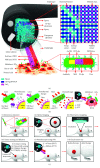Nanovectors Design for Theranostic Applications in Colorectal Cancer
- PMID: 31662751
- PMCID: PMC6791220
- DOI: 10.1155/2019/2740923
Nanovectors Design for Theranostic Applications in Colorectal Cancer
Abstract
Colorectal cancer (CRC) is a diffused disease with limited therapeutic options, none of which are often curative. Based on the molecular markers and targets expressed by the affected tissues, numerous novel approaches have been developed to study and treat this disease. In particular, the field of nanotechnology offers an astonishingly wide array of innovative nanovectors with high versatility and adaptability for both diagnosis and therapy (the so called "theranostic platforms"). However, such complexity can make the selection of a specific nanocarrier model to study a perplexing endeavour for the biomedical scientist or clinician not familiar with this field of inquiry. This review offers a comprehensive overview of this wide body of knowledge, in order to outline the essential requirements for the clinical viability evaluation of a nanovector model in CRC. In particular, the differences among the foremost designs, their specific advantages, and technological caveats will be treated, never forgetting the ultimate endpoint for these systems development: the clinical practice.
Copyright © 2019 Riccardo Rampado et al.
Conflict of interest statement
The authors declare that they have no conflicts of interest.
Figures


References
-
- Boyle P., Levin B. World Cancer Report 2008. Lyon, France: IARC Press, International Agency for Research on Cancer; 2008.
Publication types
LinkOut - more resources
Full Text Sources

